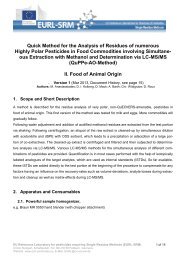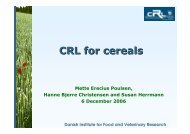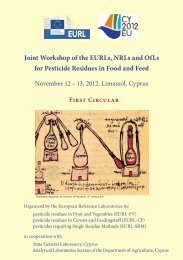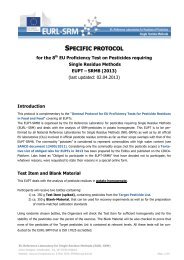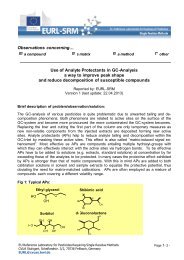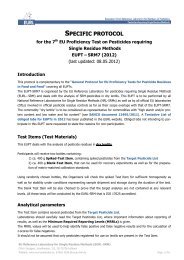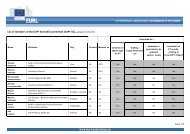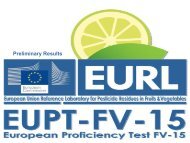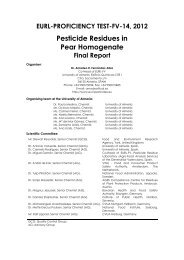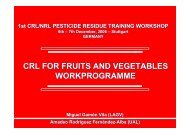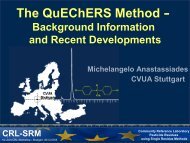Validation Report 8 - EURL | Residues of Pesticides
Validation Report 8 - EURL | Residues of Pesticides
Validation Report 8 - EURL | Residues of Pesticides
You also want an ePaper? Increase the reach of your titles
YUMPU automatically turns print PDFs into web optimized ePapers that Google loves.
<strong>EURL</strong> for Cereals and Feeding stuff<br />
National Food Institute<br />
Technical University <strong>of</strong> Denmark<br />
<strong>Validation</strong> <strong>Report</strong> 8<br />
Determination <strong>of</strong> pesticide residues in wheat, oat , rye, rice and barley by LC-MS/MS<br />
(QuEChERS method)<br />
Mette Erecius Poulsen &
March 2012
CONTENT:<br />
Page 3 <strong>of</strong> 18<br />
1. Introduction ................................................................................................................................ 4<br />
2. Principle <strong>of</strong> analysis .................................................................................................................... 4<br />
3. <strong>Validation</strong> design ........................................................................................................................ 4<br />
4. Chromatograms and calibration curves....................................................................................... 5<br />
5. <strong>Validation</strong> parameters ................................................................................................................. 8<br />
6. Criteria for the acceptance <strong>of</strong> validation results .......................................................................... 9<br />
7. Results and discussion ................................................................................................................. 9<br />
8. Conclusions................................................................................................................................. 9<br />
9. References ................................................................................................................................. 10<br />
Appendix 1. MRM transitions for the validated pesticides. ............................................................ 11<br />
Appendix 2. Recoveries, repeatability (RSDr), internal reproducibility (RSDR) and Limit <strong>of</strong><br />
Quantification (LOQ) for pesticides validated on 5 cereal commodities, wheat, oat, rye, rice and<br />
barley. ........................................................................................................................................... 12<br />
Appendix 3. Recoveries, repeatability (RSDr) and Limit <strong>of</strong> Quantification (LOQs) for pesticides<br />
validated on wheat. ....................................................................................................................... 13<br />
Appendix 4. Recoveries, repeatability (RSDr) and Limit <strong>of</strong> Quantification (LOQs) for pesticides<br />
validated on oat. ........................................................................................................................... 14<br />
Appendix 5. Recoveries, repeatability (RSDr) and Limit <strong>of</strong> Quantification (LOQs) for pesticides<br />
validated on rye. ........................................................................................................................... 15<br />
Appendix 6. Recoveries, repeatability (RSDr) and Limit <strong>of</strong> Quantification (LOQs) for pesticides<br />
validated on rice. .......................................................................................................................... 16<br />
Appendix 7. Recoveries, repeatability (RSDr) and Limit <strong>of</strong> Quantification (LOQs) for pesticides<br />
validated on barley........................................................................................................................ 17<br />
Appendix 8: Principles <strong>of</strong> the QuEChERS method for cereal extraction ........................................ 18<br />
DTU, National Food Institute
1. Introduction<br />
Page 4 <strong>of</strong> 18<br />
This report describes the validation <strong>of</strong> the QuEChERS method combined with LC-MS/MS. The<br />
method was validated for 19 pesticides and degradation products in wheat, oat , rye, rice and barley.<br />
The QuEChERS method has an extraction and clean-up step, which has been developed to be<br />
Quick, Easy, Cheap, Efficient, Rugged and Safe. The method is most commonly used on fruit,<br />
vegetables and cereals 1 .<br />
2. Principle <strong>of</strong> analysis<br />
Sample preparation: The samples is milled with a sieve at 0.1 mm.<br />
Extraction: The sample is shaken and a salt and buffer mixture is added and the sample is shaken<br />
again.<br />
Clean-up: After centrifugation the supernatant is transferred to a tube and put in -80 degree freezer.<br />
When the extract is almost thawed it is centrifuged and the supernatant is transferred to a tube with<br />
PSA and MgSO4. After shaking and an additional centrifugation step the final extract is diluted 1:1<br />
with acetonitrile to obtain the same matrix concentration as in the calibration standards. For the LC-<br />
MS/MS analysis the extraction is followed by adding internal standard and the extract is filtered<br />
into HPLC vials.<br />
Quantification and qualification:<br />
LC-MS/MS: The pesticide residues are separated on a reversed-phase column and detected by<br />
tandem mass spectrometry (MS/MS) by electrospray (ESI). The validation includes pesticides<br />
determined with both positive and negative ESI. 13 C6-carbaryl was used as internal standard for<br />
quantification. All pesticides were detected in the multiple reaction monitoring mode (MRM). For<br />
each pesticide precursor ion and 2 product ions were determined. One product ion for quantification<br />
and one for qualification. The MRM transitions for the pesticides and degradation products sought<br />
validated are given in Appendix 1.<br />
3. <strong>Validation</strong> design<br />
The method was south validated for 32 pesticides or degradation products in wheat, oat , rye, rice<br />
and barley. However, this reports only includes the LC/MS/MS results. The validation was<br />
performed on 5-6 replicates on each cereals commodity at each <strong>of</strong> the three spiking levels; 0.01,<br />
0.02 and 0.1 mg/kg. A blank sample <strong>of</strong> each cereal commodity was included.<br />
DTU, National Food Institute
Page 5 <strong>of</strong> 18<br />
4. Chromatograms and calibration curves<br />
The calibration curve is determined by the analysis <strong>of</strong> each <strong>of</strong> the analysts at least 4 calibration<br />
levels, i.e. 0.003, 0.01, 0.033 and 0.1 µg/ml. The calibration curves were best fitted to a linear<br />
curve. The quantification was performed from the mean <strong>of</strong> two bracketing calibration curves. The<br />
majority <strong>of</strong> the correlation coefficients (R) were higher or equal to 0.99. Examples <strong>of</strong><br />
chromatograms obtained when analysing the extracts by GC-MS/MS are presented in Figure 1.<br />
Examples <strong>of</strong> calibration curves are presented in Figure 2.<br />
DTU, National Food Institute
120317_17 Smooth(SG,2x1)<br />
EUPTC-2 spk. 0.02 ppm B FF 1:1<br />
100<br />
%<br />
0<br />
120317_17 Smooth(SG,2x1)<br />
EUPTC-2 spk. 0.02 ppm B FF 1:1<br />
100<br />
%<br />
0<br />
Page 6 <strong>of</strong> 18<br />
Metolachlor;19.33;5401<br />
Metolachlor<br />
19.33<br />
1893<br />
F5:MRM <strong>of</strong> 12 channels,ES+<br />
284 > 252<br />
2.300e+004<br />
F5:MRM <strong>of</strong> 12 channels,ES+<br />
286>254<br />
7.694e+003<br />
17.50 18.00 18.50 19.00 19.50 20.00 20.50 21.00 21.50<br />
120319_30 Smooth(SG,2x1)<br />
EUPTC-3 spk. 0.02 ppm F FF 1:1<br />
100<br />
%<br />
0<br />
120319_30 Smooth(SG,2x1)<br />
EUPTC-3 spk. 0.02 ppm F FF 1:1<br />
100<br />
%<br />
0<br />
Piperonylbutoxide<br />
23.09<br />
16646<br />
Piperonylbutoxide<br />
23.09<br />
3298<br />
20.50 21.00 21.50 22.00 22.50 23.00 23.50 24.00 24.50<br />
min<br />
min<br />
F6:MRM <strong>of</strong> 14 channels,ES+<br />
356 > 177<br />
5.401e+004<br />
F6:MRM <strong>of</strong> 14 channels,ES+<br />
356>119<br />
1.126e+004<br />
Figure 1: Examples <strong>of</strong> chromatograms for metolachlor/wheat and piperonylbutoxide/oat obtained<br />
when analysing extract spiked with 0.02 mg/kg (two MRM transitions are shown for each<br />
pesticide).<br />
24.20<br />
min<br />
min<br />
DTU, National Food Institute
Compound name: Metolachlor<br />
Correlation coefficient: r = 0.999001, r^2 = 0.998002<br />
Calibration curve: 98.7008 * x + 0.0136481<br />
Response type: Internal Std ( Ref 1 ), Height * ( IS Conc. / IS Height )<br />
Curve type: Linear, Origin: Exclude, Weighting: 1/x, Axis trans: None<br />
Response<br />
12.0<br />
10.0<br />
8.0<br />
6.0<br />
4.0<br />
2.0<br />
Page 7 <strong>of</strong> 18<br />
0.0<br />
Conc<br />
0.000 0.010 0.020 0.030 0.040 0.050 0.060 0.070 0.080 0.090 0.100 0.110<br />
Compound name: Piperonylbutoxide<br />
Correlation coefficient: r = 0.990058, r^2 = 0.980214<br />
Calibration curve: 114.114 * x + 0.0171424<br />
Response type: Internal Std ( Ref 1 ), Height * ( IS Conc. / IS Height )<br />
Curve type: Linear, Origin: Exclude, Weighting: 1/x, Axis trans: None<br />
Response<br />
14.0<br />
12.0<br />
10.0<br />
8.0<br />
6.0<br />
4.0<br />
2.0<br />
0.0<br />
0.000 0.010 0.020 0.030 0.040 0.050 0.060 0.070 0.080 0.090 0.100 0.110<br />
Figure 2. Examples <strong>of</strong> calibration curves for metolachlor and piperonylbutoxide (concentrations<br />
from 0.003-0.333 µg/ml)<br />
Conc<br />
DTU, National Food Institute
5. <strong>Validation</strong> parameters<br />
Page 8 <strong>of</strong> 18<br />
Precision – repeatability and internal reproducibility<br />
Repeatability was calculated for all pesticides and degradation products on all three spiking levels,<br />
both for the individual cereal commodities and for the all commodities altogether. Repeatability is<br />
given as the relative standard deviation on the result from two or more analysis at the same sample,<br />
done by the same technician, on the same instrument and within a short period <strong>of</strong> time. The internal<br />
Reproducibility is calculated for the all the cereal commodities only as the individual commodities<br />
were only analyzed once. Internal reproducibility is relative standard deviation on results obtained<br />
under reproducibility conditions, with the same method on the same sample by different operators<br />
within a larger period <strong>of</strong> time. The In-house reproducibility is a combination <strong>of</strong> the repeatability<br />
variance and the in-house reproducibility<br />
Repeatability and internal reproducibility in this validation was calculated from the 5-6 replicate<br />
determinations. Repeatability were calculated as given in ISO 5725-2 2 .<br />
Appendix 2-7 shows the relative repeatability and internal reproducibility for the validated<br />
pesticides and degradation products.<br />
Accuracy – Recovery<br />
The accuracy was determined by recovery, samples were spiked at three concentration levels. In<br />
appendix 2 and 3 recovery, repeatability and limit <strong>of</strong> quantification (LOQ) are given for the<br />
validated pesticides, isomers and degradation products for all three spiking levels (0.01 mg/kg, 0.02<br />
mg/kg and 0.1 mg/kg). Recoveries is listed in Appendix 2-7.<br />
Robustness<br />
The QuEChERS method has earlier by Anastassiades et al. 2003 1 in connection with the<br />
development <strong>of</strong> the method been shown to be robust.<br />
Limit <strong>of</strong> quantification, LOQ<br />
Quantification limits (LOQ) are calculated from the results at the lowest accepted spike level, as 6<br />
times the standard deviation (absolute recovery). The quantification limits are given in Appendix 2-<br />
7.<br />
DTU, National Food Institute
Page 9 <strong>of</strong> 18<br />
6. Criteria for the acceptance <strong>of</strong> validation results<br />
For the pesticides to be accepted as validated the following criteria for precision and trueness must<br />
to be fulfilled:<br />
1. The relative standard deviation <strong>of</strong> the repeatability must be less than or equal to the standard<br />
deviation proposed by Horwitz 3 .<br />
2. The average relative recovery must be between 70 and 120% 4 .<br />
If the above mentioned criteria have been meet, the detection limits have been calculated.<br />
7. Results and discussion<br />
The 19 pesticides were validated for all spike levels. The relative repeatability (RSDr) varied<br />
between 6-32 %, however most <strong>of</strong> the values were below 15%. For the majority <strong>of</strong> the pesticides<br />
the recovery was in the range <strong>of</strong> 70-110% at all three concentration levels. But in general the<br />
recoveries for cycloxydim was low for all commodities. The combined LOQs were in the range <strong>of</strong><br />
0.01-0.02 mg/kg, although some <strong>of</strong> the LOQs for specific commodities was seen to be higher (up to<br />
0.08 mg/kg).<br />
However, some <strong>of</strong> the pesticides were not validated on the the two lowest spike levels for some <strong>of</strong><br />
the cereal commodities.<br />
Wheat: <strong>Validation</strong> for tepraloxydim and tribenuron-methyl could not be accepted at the lowest<br />
spike level (0. 1) mg/kg.<br />
Oat: All pesticides validated at all spike levels.<br />
Rye: <strong>Validation</strong> for azimsulfuron, bensulfuron methyl, diuron, imidacloprid and triasulfuron could<br />
not be accepted at the lowest spike level (0. 1) mg/kg and cycloxydim was not accepted for the two<br />
lowest spike level (0.01 and 0.02 mg/kg).<br />
Rice: <strong>Validation</strong> for cycloxydim and dicrotophos could not be accepted at the lowest spike level (0.<br />
1) mg/kg and cycloxydim was not accepted for the two lowest spike level (0.01 and 0.02 mg/kg).<br />
Barley: All pesticides validated at all spike levels.<br />
The results for the pesticides which were accepted for LC-MS/MS are listed in Appendix 2.<br />
8. Conclusions<br />
In conclusion 19 pesticides and degradation products were validated on wheat, oat , rye, rice and<br />
barley for the QuEChERS method using LC-MS/MS for the analysis.<br />
DTU, National Food Institute
9. References<br />
Page 10 <strong>of</strong> 18<br />
1 http://www.quechers.com/ or Anastassiades et al., J. AOAC Int., vol. 86, no. 2, p. 412, 2003<br />
2 ISO 5725-2:1994. Accuracy (trueness and precision) <strong>of</strong> measurement methods and results – Part2.<br />
Basic method for the determination <strong>of</strong> repeatability and reproducibility <strong>of</strong> standard measurement<br />
method. First edition. December 1994.<br />
3 W. Horwitz, Anal. Chem., 1982; 54, 67A.<br />
4 Method <strong>Validation</strong> and Quality Control Procedures for Pesticide Residue Analysis in Food and<br />
Feed, Document No SANCO/10684/2010, 01/01/2010, European Commission, Brussels, 2010.<br />
5 EU <strong>Pesticides</strong> database available at http://ec.europa.eu/sanco_pesticides/public/index.cfm<br />
DTU, National Food Institute
Appendix 1. MRM transitions for the validated pesticides.<br />
Page 11 <strong>of</strong> 18<br />
LC-MS/MS ESI- Precursor ion-1 Product ion-1 CV CE Precursor ion-2 Product ion-2 CE CV<br />
1 Azimsulfuron 425 182 52 11 425 182 52 25<br />
2 Bensulfuron methyl 411 149 21 30 411 182 21 20<br />
3 Benzobicyclon 447 257 27 15 447 229 27 25<br />
4 Cycloxydim 326 280 10 11 326 180 10 22<br />
5 Dicrotophos 270 112 28 15 255 193 28 21<br />
6 Diuron *) 231 186 16 15 231 150 16 15<br />
7 Imidacloprid 256 209 21 15 256 175 20 20<br />
8 Isoprothiolane 291 231 10 10 291 189 10 21<br />
9 Mandipropamid 412 328 40 15 412 125 40 39<br />
10 Mesotrione *) 338 291 16 15 338 212 16 27<br />
11 Metamitron 203 104 34 33 203 77 34 33<br />
12 Metolachlor 284 252 28 15 286 254 28 15<br />
13 Nitenpyram 271 126 28 15 271 190 28 15<br />
14 Piperonylbutoxide 356 177 10 15 356 119 10 33<br />
15 Prothioconazole desthio 312 70 15 21 314 127 15 20<br />
16 Tepraloxydim 342 166 25 25 342 250 20 20<br />
17 Thifensulfuron-methyl *) 482 204 40 15 147 88 40 33<br />
18 Triasulfuron 402 167 52 17 402 141 52 22<br />
19 Tribenuron methyl 396 155 52 17 396 181 50 20<br />
*) <strong>Pesticides</strong> analysed by negative ESI<br />
DTU, National Food Institute
Page 12 <strong>of</strong> 18<br />
Appendix 2. Recoveries, repeatability (RSDr), internal reproducibility (RSDR) and Limit <strong>of</strong> Quantification (LOQ) for<br />
pesticides validated on 5 cereal commodities, wheat, oat, rye, rice and barley.<br />
Wheat, oat, rye, rice<br />
and barley - QuEChERS<br />
Spike level<br />
Spike level<br />
Spike level<br />
mg/kg Horwitz, %<br />
mg/kg Horwitz, %<br />
mg/kg Horwitz, %<br />
0.01 32 0.02 29 0.1 23<br />
Recovery,<br />
%<br />
RSDr,<br />
%<br />
RSDR,<br />
%<br />
Recovery,<br />
%<br />
RSDr,<br />
%<br />
RSDR,<br />
%<br />
Recovery,<br />
%<br />
RSDr,<br />
%<br />
RSDR,<br />
% LOQ<br />
Azimsulfuron 96 24 27 90 12 17 92 9 12 0.02<br />
Bensulfuron methyl 72 20 26<br />
Benzobicyclon 96 22 29<br />
Cycloxydim 69 21 27<br />
Dicrotophos 109 16 18<br />
Diuron *) 109 15 18<br />
Imidacloprid 105 32 32<br />
Isoprothiolane 110 12 13<br />
Mandipropamid 105 14 14<br />
Mesotrione *) 106 21 31<br />
Metamitron 102 29 29<br />
Metolachlor 107 17 17<br />
Nitenpyram 86 30 30<br />
Piperonylbutoxide 104 15 14<br />
Prothioconazole desthio 95 28 30<br />
Tepraloxydim 101 25 32<br />
Thifensulfuron-methyl *) 99 18 23<br />
Triasulfuron 70 20 27<br />
67 12 19<br />
84 20 26<br />
60 17 35<br />
110 10 10<br />
110 11 11<br />
106 17 21<br />
103 6 7<br />
104 11 13<br />
90 16 21<br />
107 27 27<br />
104 6 6<br />
95 21 22<br />
99 9 11<br />
87 16 18<br />
74 21 24<br />
82 12 21<br />
72 13 17<br />
66 10 17 0.01<br />
87 11 22 0.01<br />
61 14 22 0.01<br />
105 14 14 0.01<br />
91 8 8 0.01<br />
110 12 12 0.02<br />
99 9 9 0.01<br />
99 11 11 0.01<br />
76 10 20 0.02<br />
109 17 17 0.02<br />
98 10 10 0.01<br />
100 13 14 0.02<br />
91 13 14 0.01<br />
95 13 15 0.02<br />
71 12 22 0.02<br />
63 11 22 0.01<br />
73 11 17 0.01<br />
Tribenuron methyl 108 28 31 87 24 27 85 15 20 0.02<br />
*) <strong>Pesticides</strong> analysed by negative ESI<br />
DTU, National Food Institute
Page 13 <strong>of</strong> 18<br />
Appendix 3. Recoveries, repeatability (RSDr) and Limit <strong>of</strong> Quantification (LOQs) for pesticides validated on wheat.<br />
Wheat - QuEChERS<br />
Spike level<br />
Spike level<br />
Spike level<br />
mg/kg Horwitz, % mg/kg Horwitz, % mg/kg Horwitz, %<br />
0.01 32 0.02 29 0.1 23<br />
Recovery,<br />
%<br />
RSDr,<br />
%<br />
Recovery,<br />
%<br />
RSDr,<br />
%<br />
Recovery,<br />
%<br />
RSDr,<br />
% LOQ<br />
Azimsulfuron 110 30 95 9 98 14 0.02<br />
Bensulfuron methyl 71 21<br />
Benzobicyclon 114 29<br />
Cycloxydim 78 32<br />
Dicrotophos 110 29<br />
Diuron *) 93 29<br />
Imidacloprid 119 31<br />
Isoprothiolane 96 27<br />
Mandipropamid 82 27<br />
Mesotrione *) 92 30<br />
Metamitron 107 37<br />
Metolachlor 112 31<br />
Nitenpyram 77 19<br />
Piperonylbutoxide 100 29<br />
Prothioconazole desthio 85 16<br />
Tepraloxydim<br />
Thifensulfuron-methyl *) 89 23<br />
Triasulfuron 63 17<br />
64 6<br />
103 29<br />
62 14<br />
103 7<br />
114 10<br />
79 17<br />
106 6<br />
116 8<br />
96 14<br />
109 23<br />
105 4<br />
81 10<br />
109 7<br />
103 14<br />
74 19<br />
80 11<br />
65 7<br />
65 12 0.01<br />
111 16 0.02<br />
66 12 0.01<br />
105 19 0.02<br />
95 10 0.02<br />
106 11 0.02<br />
106 14 0.02<br />
100 14 0.01<br />
79 12 0.02<br />
107 19 0.02<br />
101 13 0.02<br />
96 15 0.01<br />
103 12 0.02<br />
110 17 0.01<br />
71 7 0.03<br />
62 13 0.01<br />
72 13 0.01<br />
Tribenuron methyl 92 20 74 15 0.03<br />
*) <strong>Pesticides</strong> analysed by negative ESI<br />
DTU, National Food Institute
Page 14 <strong>of</strong> 18<br />
Appendix 4. Recoveries, repeatability (RSDr) and Limit <strong>of</strong> Quantification (LOQs) for pesticides validated on oat.<br />
Oat - QuEChERS<br />
Spike level<br />
Spike level<br />
Spike level<br />
mg/kg Horwitz, % mg/kg Horwitz, % mg/kg Horwitz, %<br />
0.01 32 0.02 29 0.1 23<br />
Recovery,<br />
%<br />
RSDr,<br />
%<br />
Recovery,<br />
%<br />
RSDr,<br />
%<br />
Recovery,<br />
%<br />
RSDr,<br />
% LOQ<br />
Azimsulfuron 106 10 103 9 100 9 0.01<br />
Bensulfuron methyl 81 6<br />
Benzobicyclon 104 12<br />
Cycloxydim 76 7<br />
Dicrotophos 117 8<br />
Diuron *) 120 6<br />
Imidacloprid 105 12<br />
Isoprothiolane 112 7<br />
Mandipropamid 105 10<br />
Mesotrione *) 114 13<br />
Metamitron 107 28<br />
Metolachlor 106 5<br />
Nitenpyram 85 26<br />
Piperonylbutoxide 108 7<br />
Prothioconazole desthio 93 28<br />
Tepraloxydim 114 23<br />
Thifensulfuron-methyl *) 114 13<br />
Triasulfuron 88 22<br />
84 6<br />
87 10<br />
78 14<br />
108 7<br />
109 10<br />
113 17<br />
100 6<br />
95 8<br />
104 14<br />
116 23<br />
101 4<br />
99 10<br />
91 7<br />
87 14<br />
91 19<br />
104 11<br />
84 7<br />
81 6 0.01<br />
88 8 0.01<br />
77 7 0.01<br />
99 8 0.01<br />
90 9 0.01<br />
113 8 0.01<br />
97 6 0.01<br />
95 16 0.01<br />
89 11 0.01<br />
107 15 0.02<br />
97 8 0.01<br />
95 15 0.01<br />
91 15 0.01<br />
89 7 0.02<br />
89 11 0.02<br />
83 11 0.01<br />
88 7 0.01<br />
Tribenuron methyl 119 30 101 20 107 10 0.02<br />
*) <strong>Pesticides</strong> analysed by negative ESI<br />
DTU, National Food Institute
Page 15 <strong>of</strong> 18<br />
Appendix 5. Recoveries, repeatability (RSDr) and Limit <strong>of</strong> Quantification (LOQs) for pesticides validated on rye.<br />
Rye - QuEChERS<br />
Spike level<br />
Spike level<br />
Spike level<br />
mg/kg Horwitz, % mg/kg Horwitz, % mg/kg Horwitz, %<br />
0.01 32 0.02 29 0.1 23<br />
Recovery,<br />
%<br />
RSDr,<br />
%<br />
Recovery,<br />
%<br />
RSDr,<br />
%<br />
Recovery,<br />
%<br />
RSDr,<br />
% LOQ<br />
Azimsulfuron 93 13 93 7 0.02<br />
Bensulfuron methyl<br />
Benzobicyclon 110 27<br />
Cycloxydim<br />
Dicrotophos 92 11<br />
Diuron *)<br />
Imidacloprid<br />
Isoprothiolane 112 9<br />
Mandipropamid 106 1<br />
Mesotrione *) 116 6<br />
Metamitron 80 3<br />
Metolachlor 104 9<br />
Nitenpyram 105 2<br />
Piperonylbutoxide 104 15<br />
Prothioconazole desthio 113 20<br />
Tepraloxydim 91 12<br />
Thifensulfuron-methyl *) 114 21<br />
Triasulfuron<br />
71 7<br />
90 20<br />
115 6<br />
106 9<br />
109 21<br />
106 5<br />
109 11<br />
81 14<br />
105 9<br />
103 5<br />
105 17<br />
99 9<br />
79 14<br />
69 13<br />
67 11<br />
80 10<br />
66 14 0.02<br />
87 10 0.02<br />
56 23 0.08<br />
112 13 0.01<br />
86 8 0.02<br />
115 2 0.03<br />
99 12 0.01<br />
96 7 0.01<br />
70 5 0.01<br />
112 19 0.01<br />
97 14 0.01<br />
104 12 0.01<br />
91 13 0.01<br />
90 18 0.01<br />
67 12 0.01<br />
51 10 0.01<br />
71 13 0.01<br />
Tribenuron methyl 119 15 88 24 82 21 0.01<br />
*) <strong>Pesticides</strong> analysed by negative ESI<br />
DTU, National Food Institute
Page 16 <strong>of</strong> 18<br />
Appendix 6. Recoveries, repeatability (RSDr) and Limit <strong>of</strong> Quantification (LOQs) for pesticides validated on rice.<br />
Rice - QuEChERS<br />
Spike level<br />
Spike level<br />
Spike level<br />
mg/kg Horwitz, % mg/kg Horwitz, % mg/kg Horwitz, %<br />
0.01 32 0.02 29 0.1 23<br />
Recovery,<br />
%<br />
RSDr,<br />
%<br />
Recovery,<br />
%<br />
RSDr,<br />
%<br />
Recovery,<br />
%<br />
RSDr,<br />
% LOQ<br />
Azimsulfuron 76 17 82 8 91 6 0.01<br />
Bensulfuron methyl 64 14<br />
Benzobicyclon 93 16<br />
Cycloxydim<br />
Dicrotophos<br />
Diuron *) 103 15<br />
Imidacloprid 110 18<br />
Isoprothiolane 115 9<br />
Mandipropamid 106 8<br />
Mesotrione *) 106 16<br />
Metamitron 115 23<br />
Metolachlor 104 9<br />
Nitenpyram 62 16<br />
Piperonylbutoxide 96 6<br />
Prothioconazole desthio 98 20<br />
Tepraloxydim 92 26<br />
Thifensulfuron-methyl *) 102 17<br />
Triasulfuron 58 12<br />
60 11<br />
80 10<br />
107 12<br />
114 19<br />
103 6<br />
104 8<br />
97 15<br />
103 25<br />
108 4<br />
103 18<br />
99 5<br />
78 10<br />
73 18<br />
89 12<br />
67 16<br />
63 6 0.01<br />
84 9 0.01<br />
56 16 0.05<br />
112 3 0.05<br />
91 5 0.01<br />
117 8 0.01<br />
101 4 0.01<br />
107 8 0.01<br />
86 7 0.01<br />
108 18 0.02<br />
102 4 0.01<br />
108 9 0.01<br />
93 5 0.01<br />
100 6 0.01<br />
78 16 0.01<br />
64 4 0.01<br />
73 10 0.01<br />
Tribenuron methyl 112 18 92 12 88 17 0.01<br />
*) <strong>Pesticides</strong> analysed by negative ESI<br />
DTU, National Food Institute
Page 17 <strong>of</strong> 18<br />
Appendix 7. Recoveries, repeatability (RSDr) and Limit <strong>of</strong> Quantification (LOQs) for pesticides validated on barley.<br />
Barley - QuEChERS<br />
Spike level<br />
Spike level<br />
Spike level<br />
mg/kg Horwitz, % mg/kg Horwitz, % mg/kg Horwitz, %<br />
0.01 32 0.02 29 0.1 23<br />
Recovery,<br />
%<br />
RSDr,<br />
%<br />
Recovery,<br />
%<br />
RSDr,<br />
%<br />
Recovery,<br />
%<br />
RSDr,<br />
% LOQ<br />
Azimsulfuron 84 5 76 10 80 6 0.01<br />
Bensulfuron methyl 60 9<br />
Benzobicyclon 67 19<br />
Cycloxydim 53 11<br />
Dicrotophos 116 8<br />
Diuron *) 120 10<br />
Imidacloprid 102 17<br />
Isoprothiolane 110 8<br />
Mandipropamid 118 15<br />
Mesotrione *) 73 17<br />
Metamitron 90 27<br />
Metolachlor 107 2<br />
Nitenpyram 76 5<br />
Piperonylbutoxide 110 5<br />
Prothioconazole desthio 91 15<br />
Tepraloxydim 84 24<br />
Thifensulfuron-methyl *) 78 7<br />
Triasulfuron 64 18<br />
57 15<br />
62 16<br />
41 3<br />
114 4<br />
114 12<br />
117 14<br />
101 8<br />
99 12<br />
70 18<br />
98 28<br />
103 4<br />
79 24<br />
94 5<br />
88 10<br />
64 11<br />
70 16<br />
64 18<br />
55 11 0.01<br />
63 5 0.01<br />
49 3 0.01<br />
104 4 0.01<br />
92 7 0.01<br />
113 4 0.01<br />
95 3 0.01<br />
96 5 0.01<br />
60 5 0.01<br />
114 13 0.01<br />
96 5 0.01<br />
94 16 0.01<br />
85 3 0.01<br />
87 9 0.01<br />
53 13 0.01<br />
57 11 0.01<br />
60 10 0.01<br />
Tribenuron methyl 97 18 94 16 76 8 0.01<br />
*) <strong>Pesticides</strong> analysed by negative ESI<br />
DTU, National Food Institute
Page 18 <strong>of</strong> 18<br />
Appendix 8: Principles <strong>of</strong> the QuEChERS method for cereal extraction<br />
QuEChERS for cereals<br />
(FP417)<br />
Weigh 5 g (±0.05 g) <strong>of</strong> flour into a 50 ml single use centrifuge tube (red cap).<br />
Add internal standard and/or spike standard (maximum 25 µl)<br />
Add a ceramic homogenizer and 10 g <strong>of</strong> cold water and shake briefly<br />
Add 10 ml acetonitrile and shake vigorously by hand for 1 min. (1. extraction)<br />
Add the prepared mixture <strong>of</strong> 4 g MgSO 4, 1 g NaCl, 1 g Na 3 citrate dihydrate and<br />
0.5 g Na 2H cirate sesquihydrate. Shake for a few seconds after each addition to<br />
prevent lumps.<br />
Shake vigorously for 1 min. (2. Extraction with phase separation)<br />
Centrifuge for 10 min at 4500 rpm<br />
Transfer at least 8 ml <strong>of</strong> the extract to a 15 ml single use centrifuge tube and<br />
store in the freezer (-80˚C for 1 hour or over night). When the extract are almost<br />
thawed (i.e. About -40 ˚C) centrifugate (should be cold 5 C) for 5 min. at 4500<br />
rpm.<br />
Transfer 6 ml <strong>of</strong> the cold extract to a 15 ml single use centrifuge tube containing<br />
150 mg PSA and 900 mg MgSO 4. Close the tube and shake vigorously for 30<br />
seconds.<br />
Centrifuge for 5 min. at 4500 rpm<br />
Transfer 4 ml <strong>of</strong> the extract to a 15 ml single use centrifuge tube. Add 40 µl <strong>of</strong><br />
5% formic acid solution in acetonitrile (10 µl/ml extract). Dilute the extract 1:1<br />
with acetonitrile<br />
Transfer the final extract into auto sampler vials and analyse by GC and LC.<br />
DTU, National Food Institute



